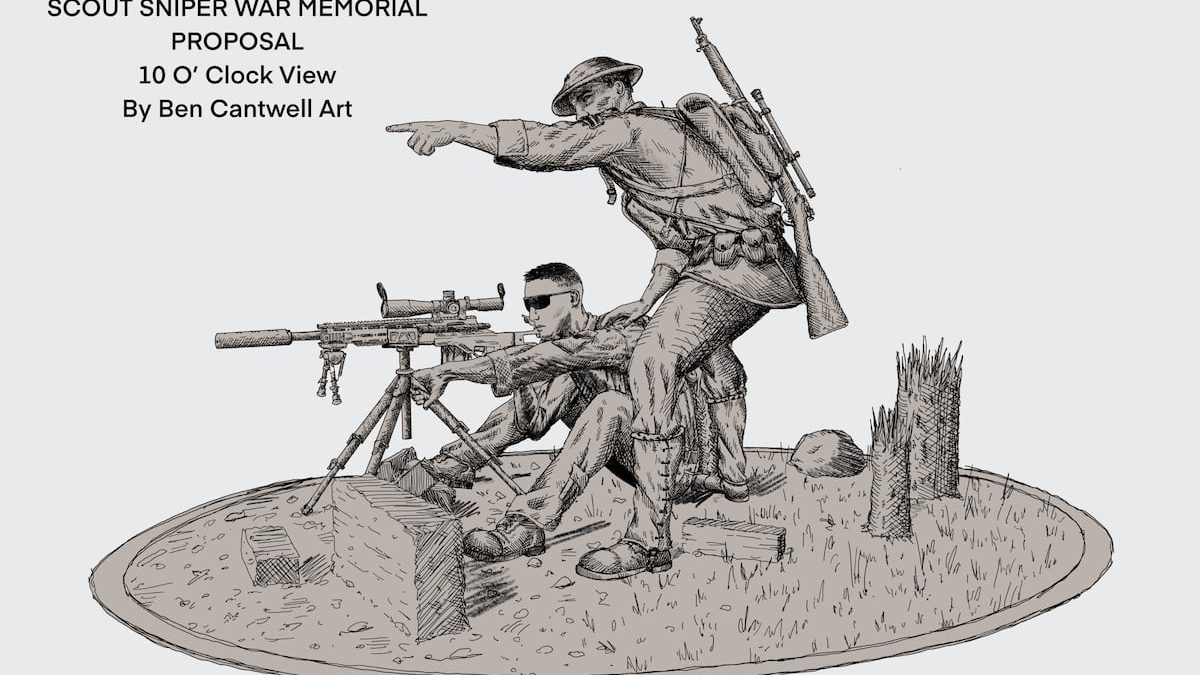The Marine Corps sniper community is seeking honor their community’s fallen via a new war memorial.
Members of the Marine Scout Sniper Heritage Foundation have a long-term plan, design and are raising the necessary $5 million it will take to build the Marine Scout Sniper War Memorial at the National Museum of the Marine Corps in Quantico, Virginia.
The team is selling raffle tickets now for its first annual raffle of an authentic Marine M40 sniper rifle used in combat in the Vietnam War.
The rifle and its components are valued at about $15,000. Those interested can purchase raffle tickets on the foundation website. The drawing will be held on Thanksgiving.
RELATED
Retired Master Sgt. Tim Parkhurst heads the foundation, which is partnered with the Marine Scout Sniper Association, and is trying to appeal to a wide swath of veteran supporters to raise funds for the project.
“Our mission is to remember the sacrifice and honor the legacy of 105 years of scout sniper service,” Parkhurst said. “We feel like your average patriotic American out to be able to get behind this.”
The names of the fallen will be included on the memorial when completed, and Parkhurst and his team are digging through thousands of personnel records from over more than 100 years to identify who served as snipers and who among them died because of combat action.
The project started earlier this year, and so far, the team has nearly 3,000 names, with likely a few thousand more to be added.
Parkhurst estimates that they’ve discovered nearly 250 Marine scout snipers killed in action so far.
The foundation has already paid the $105,000 fee to secure the spot for the memorial at the Marine museum. Once the total amount is raised, construction could be completed in under 18 months, Parkhurst said.
Parkhurst joined the Corps in 1986 and graduated scout sniper training in 1991. He later served as a sniper team leader with the Surveillance and Target Acquisition Platoon, 3rd Battalion, 5th Marine Regiment before briefly leaving the military.
“It was the best time of my life,” Parkhurst said.
Parkhurst rejoined the Corps five years later, ultimately serving 25 years and retiring in 2014.

But he didn’t serve the rest of that time as a sniper, because in the Corps’ infinite wisdom, they made him a parachute rigger.
The master sergeant’s story is a common one among generations of Marine snipers – early training, perhaps a deployment and then it’s time for those snipers to return to their primary jobs.
The job of sniper is not a primary military occupational specialty, and that has ramifications on the work that Parkhurst and his team are doing to honor the fallen scout snipers going back to at least 1918.
“It was never treated like a real job,” Parkhurst said. “It’s something they sort of grudgingly acknowledged they need when the war starts.”
And in this current interwar period, snipers have once again fallen victim to defense cuts.
Marine Corps Times reported that the service held its final Scout Sniper Course graduation at the School of Infantry-East at Camp Geiger, North Carolina in December 2023.
Earlier that year, the Corps announced it would cut scout sniper platoons from its infantry battalions and replace them with reconnaissance scout platoons as part of restructuring the service has conducted in recent years to prepare for potential conflicts with nations such as China and Russia.
Scout sniper training will continue at the service’s Reconnaissance Training Center and the Marine Raider Training Center, Marine Corps Times previously reported.
Because the scout sniper platoons have been treated as an add-on to infantry battalions, their members have often fallen under their respective infantry communities, Parkhurst said.
While the Marine Raiders, Navy SEALs, Army Green Berets and even Recon Marines have an identifiable parent unit, primary MOS and officer and staff noncommissioned officer with the same job, most snipers saw their careers as shooters end at the rank of staff sergeant.
It wasn’t until the early 2000s that snipers received dedicated officers to command their units. Before then, Parkhurst said, one of the infantry battalion or division staff officers would oversee snipers.
Todd South has written about crime, courts, government and the military for multiple publications since 2004 and was named a 2014 Pulitzer finalist for a co-written project on witness intimidation. Todd is a Marine veteran of the Iraq War.
Read the full article here


